克鲁格曼《国际经济学》(第8版)笔记和课后习题详解 第2章~第4章【圣才出品】
克鲁格曼《国际经济学》第8版笔记和课后习题详解(宏观经济政策和浮动汇率制下的国际协调)【圣才出品】
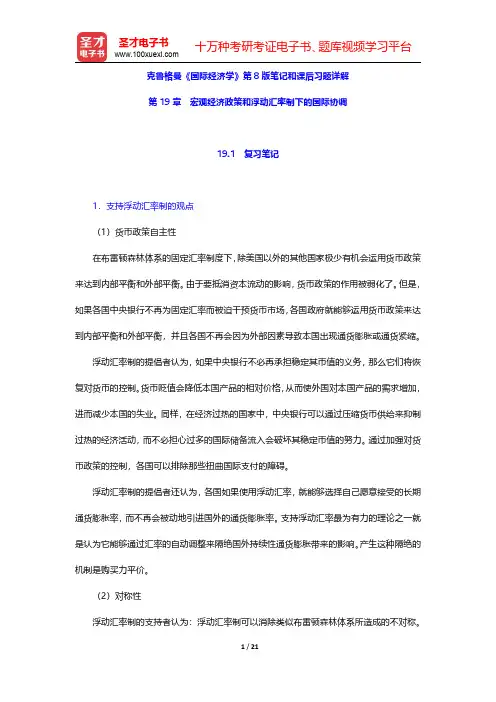
克鲁格曼《国际经济学》第8版笔记和课后习题详解第19章宏观经济政策和浮动汇率制下的国际协调19.1复习笔记1.支持浮动汇率制的观点(1)货币政策自主性在布雷顿森林体系的固定汇率制度下,除美国以外的其他国家极少有机会运用货币政策来达到内部平衡和外部平衡。
由于要抵消资本流动的影响,货币政策的作用被弱化了。
但是,如果各国中央银行不再为固定汇率而被迫干预货币市场,各国政府就能够运用货币政策来达到内部平衡和外部平衡,并且各国不再会因为外部因素导致本国出现通货膨胀或通货紧缩。
浮动汇率制的提倡者认为,如果中央银行不必再承担稳定其币值的义务,那么它们将恢复对货币的控制。
货币贬值会降低本国产品的相对价格,从而使外国对本国产品的需求增加,进而减少本国的失业。
同样,在经济过热的国家中,中央银行可以通过压缩货币供给来抑制过热的经济活动,而不必担心过多的国际储备流入会破坏其稳定币值的努力。
通过加强对货币政策的控制,各国可以排除那些扭曲国际支付的障碍。
浮动汇率制的提倡者还认为,各国如果使用浮动汇率,就能够选择自己愿意接受的长期通货膨胀率,而不再会被动地引进国外的通货膨胀率。
支持浮动汇率最为有力的理论之一就是认为它能够通过汇率的自动调整来隔绝国外持续性通货膨胀带来的影响。
产生这种隔绝的机制是购买力平价。
(2)对称性浮动汇率制的支持者认为:浮动汇率制可以消除类似布雷顿森林体系所造成的不对称。
由于各国不再将本国货币钉住对美元的汇率,也就不必因此而持有美元作储备。
所以,各国都可以自主决定本国的货币状况。
同样,美国在运用货币政策或财政政策改变美元汇率时,不会再遇到特别的阻碍。
最后,在全球范围内,所有国家的汇率都将由市场而不是由政府决定。
(3)汇率自动稳定器功能与固定汇率相比,浮动汇率相对减少了需求冲击对就业的影响,从而有利于经济稳定。
当对本国产品和劳务的需求下降时,浮动汇率下的货币贬值,会使本国产品和劳务的价格下降,部分地减轻了这种需求下降的不利影响。
《克鲁格曼 国际经济学 第8版 笔记和课后习题详解》读书笔记思维导图
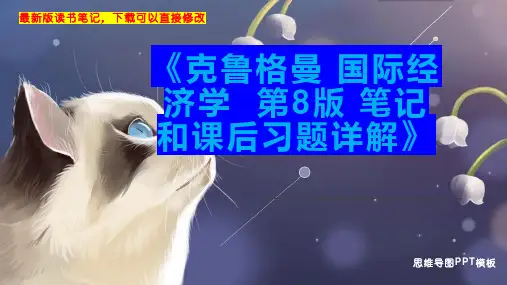
《克鲁格曼 国际经 济学 第8版 笔记 和课后习题详解》
思维导图PPT模板
本书关键字分析思维导图
经济学
克鲁格曼
名校
笔记
教材
贸易
经济
பைடு நூலகம்
国际
习题
政策 汇率
国际贸易
第章
第版
模型
货币
参考书目
答案
精华
01 第1章 绪 论
目录
02 第1篇 国际贸易理论
03 第2篇 国际贸易政策
第1章 绪 论
第1篇 国际贸易理论
01
第2章 世 界贸易概览
02
第3章 劳 动生产率和 比较优势: 李嘉图模型
03
第4章 资 源、比较优 势与收入分 配
04
第5章 标 准贸易模型
06
第7章 国 际要素流动
05
第6章 规 模经济、不 完全竞争和 国际贸易
第2篇 国际贸易政策
第8章 贸易的政 策工具
05
第4篇 国际宏观经济 政策
04
第3篇 汇率与开放经 济的宏观经济学
本书特别适用于参加研究生入学考试指定考研参考书目为克鲁格曼所著的《国际经济学》(第8版)的考生。 克鲁格曼所著的《国际经济学》(中国人民大学出版社)被列为“十一五”国家重点图书出版规划项目,是我国 众多高校采用的国际经济学权威教材,也被众多高校指定为“国际经济学”等专业考研(含复试)参考书目。为 了帮助考生复习备考,我们精心编著了它的配套辅导用书(均提供免费下载,免费升级):1.克鲁格曼《国际经 济学》(第8版)笔记和课后习题详解2.克鲁格曼《国际经济学》名校考研真题与典型题详解3.克鲁格曼《国 际经济学》(第8版)课后习题详解4.克鲁格曼《国际经济学》配套题库【名校考研真题+课后习题+章节练习+ 模拟试题】本书是克鲁格曼《国际经济学》(第8版)教材的配套e书,严格按照克鲁格曼《国际经济学》(第8 版)教材内容进行编写,共分22章,主要包括以下内容:(1)整理名校笔记,浓缩内容精华。每章的复习笔记 以克鲁格曼所著的《国际经济学》(第8版)为主,并结合国内其他国际经济学经典教材对各章的重难点进行了整 理,因此,本书的内容几乎浓缩了经典教材的知识精华。(2)解析课后习题,提供详尽答案。本书参考大量相关 辅导资料对克鲁格曼所著的《国际经济学》(第8版)的课后习题进行了详细的分析和解答,并对相关重要知识点 进行了延伸和归纳。另外,还提供英文版原题,以便于学员复习备考。(3)最新笔记和课后习题答案,可免费升 级获得。本e书每年都会进行修订完善,补充最新的笔记和课后习题答案。对于最新补充的笔记和课后习题答案, 均可以免费升级获得。
国际经济学克鲁格曼课后习题答案章完整版
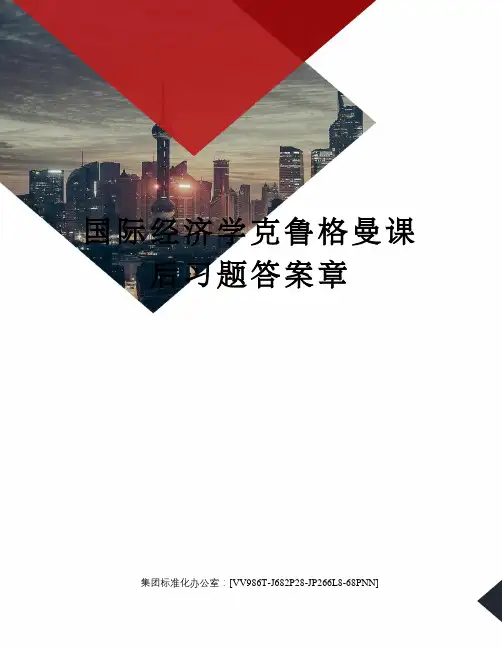
国际经济学克鲁格曼课后习题答案章集团标准化办公室:[VV986T-J682P28-JP266L8-68PNN]第一章练习与答案1.为什么说在决定生产和消费时,相对价格比绝对价格更重要?答案提示:当生产处于生产边界线上,资源则得到了充分利用,这时,要想增加某一产品的生产,必须降低另一产品的生产,也就是说,增加某一产品的生产是有机会机本(或社会成本)的。
生产可能性边界上任何一点都表示生产效率和充分就业得以实现,但究竟选择哪一点,则还要看两个商品的相对价格,即它们在市场上的交换比率。
相对价格等于机会成本时,生产点在生产可能性边界上的位置也就确定了。
所以,在决定生产和消费时,相对价格比绝对价格更重要。
2.仿效图1—6和图1—7,试推导出Y商品的国民供给曲线和国民需求曲线。
答案提示:3.在只有两种商品的情况下,当一个商品达到均衡时,另外一个商品是否也同时达到均衡?试解释原因。
答案提示:4.如果生产可能性边界是一条直线,试确定过剩供给(或需求)曲线。
答案提示:5.如果改用Y商品的过剩供给曲线(B国)和过剩需求曲线(A国)来确定国际均衡价格,那么所得出的结果与图1—13中的结果是否一致?6.答案提示:国际均衡价格将依旧处于贸易前两国相对价格的中间某点。
7.说明贸易条件变化如何影响国际贸易利益在两国间的分配。
答案提示:一国出口产品价格的相对上升意味着此国可以用较少的出口换得较多的进口产品,有利于此国贸易利益的获得,不过,出口价格上升将不利于出口数量的增加,有损于出口国的贸易利益;与此类似,出口商品价格的下降有利于出口商品数量的增加,但是这意味着此国用较多的出口换得较少的进口产品。
对于进口国来讲,贸易条件变化对国际贸易利益的影响是相反的。
8.如果国际贸易发生在一个大国和一个小国之间,那么贸易后,国际相对价格更接近于哪一个国家在封闭下的相对价格水平?答案提示:贸易后,国际相对价格将更接近于大国在封闭下的相对价格水平。
克鲁格曼国际经济学第八版上册课后答案

Chapter 4Resources, Comparative Advantage, and Income DistributionChapter OrganizationA Model of a Two-Factor EconomyPrices and ProductionChoosing the Mix of InputsFactor Prices and Goods PricesResources and OutputEffects of International Trade Between Two-Factor Economies Relative Prices and the Pattern of TradeTrade and the Distribution of IncomeFactor Price EqualizationTrade and Income Distribution in the Short RunCase Study: North-South Trade and Income InequalityThe Political Economy of Trade: A Preliminary ViewThe Gains from Trade, RevisitedOptimal Trade PolicyIncome Distribution and Trade PoliticsBox: Income Distribution and the Beginnings of Trade Theory Empirical Evidence on the Heckscher-Ohlin ModelTesting the Heckscher-Ohlin ModelImplications of the TestsSummaryAppendix: Factor Prices, Goods Prices, and Input Choices Choice of TechniqueGoods Prices and Factor PricesChapter OverviewIn Chapter 3, trade between nations was motivated by differences internationally in the relative productivity of workers when producing a range of products. In Chapter 4, this analysis goes a step further by introducing the Heckscher-Ohlin theory.The Heckscher-Ohlin theory considers the pattern of production and trade which will arise when countries have different endowments of factors of production, such as labor, capital, and land. The basic point is that countries tend to export goods that are intensive in the factors with which they are abundantly supplied. Trade has strong effects on the relative earnings of resources, and tends to lead to equalization across countries of prices of the factors of production. These theoretical results and related empirical findings are presented in this chapter.The chapter begins by developing a general equilibrium model of an economy with two goods which are each produced using two factors according to fixed coefficient production functions. The assumption of fixed coefficient production functions provides an unambiguous ranking of goods in terms of factor intensities. (The appendix develops the model when the production functions have variable coefficients.) Two important results are derived using this model. The first is known as the Rybczynski effect. Increasing the relative supply of one factor, holding relative goods prices constant, leads to a biased expansion of production possibilities favoring the relative supply of the good which uses that factor intensively.The second key result is known as the Stolper-Samuelson effect. Increasing the relative price of a good, holding factor supplies constant, increases the return to the factor used intensively in the production of that good by more than the price increase, while lowering the return to the other factor. This result has important income distribution implications.It can be quite instructive to think of the effects of demographic/labor force changes on the supply of different products. For example, how might the pattern of production during the productive years of the “Baby Boom” generation differ from the pattern of production for post Baby Boom generations? What does this imply for returns to factors and relative price behavior?The central message concerning trade patterns of the Heckscher-Ohlin theory is that countries tend to export goods whose production is intensive in factors with which they are relatively abundantly endowed. This is demonstrated by showing that, using the relative supply and relative demand analysis, the country relatively abundantly endowed with a certain factor will produce that factor more cheaply than the other country. International trade leads to a convergence of goods prices. Thus, the results from the Stolper-Samuelson effect demonstrate that owners of a country’s abundant factors gain from trade, but ownersof a country’s scarce factors lose. The extension of this result is the important Factor Price Equalization Theorem, which states that trade in (and thus price equalization of) goods leads to an equalization in the rewards to factors across countries. The political implications of factor price equalization should be interesting to students.The chapter also introduces some political economy considerations. First, it briefly notes that many of the results regarding trade and income distribution assume full and swift adjustment in the economy. In the short run, though, labor and capital that are currently in a particular industry may have sector-specific skills or knowledge and are being forced to move to another sector, and this involves costs. Thus, even if a shift in relative prices were to improve the lot of labor, for those laborers who must change jobs, there is a short run cost.The core of the political economy discussion focuses on the fact that when opening to trade, some may benefit and some may lose, but the expansion of economic opportunity should allow society to redistribute some of the gains towards those who lose, making sure everyone benefits on net. In practice, though, those who lose are often more concentrated and hence have more incentive to try to affect policy. Thus, trade policy is not always welfare maximizing, but may simply reflect the preferences of the loudest and best organized in society.Empirical results concerning the Heckscher-Ohlin theory, beginning with the Leontief paradox and extending to current research, do not support its predictions concerning resource endowments explaining overall patterns of trade, though some patterns do match the broad outlines of its theory (e.g., theUnited States imports more low-skill products from Bangladesh and more high-skill products from Germany). This observation has motivated many economists to consider motives for trade between nations that are not exclusively based on differences across countries. These concepts will be exploredin later chapters. Despite these shortcomings, important and relevant results concerning income distribution are obtained from the Heckscher-Ohlin theory.Answers to Textbook Problems1. The definition of cattle growing as land intensive depends on the ratio of land to labor used inproduction, not on the ratio of land or labor to output. The ratio of land to labor in cattle exceeds the ratio in wheat in the United States, implying cattle is land intensive in the United States. Cattle is land intensive in other countries as well if the ratio of land to labor in cattle production exceeds the ratio in wheat production in that country. Comparisons between another country and the United States is less relevant for this purpose.2. a. The box diagram has 600 as the length of two sides (representing labor) and 60 as the lengthof the other two sides (representing land). There will be a ray from each of the two cornersrepresenting the origins. To find the slopes of these rays we use the information from the questionconcerning the ratios of the production coefficients. The question states that a LC/a TC= 20 anda LF/a TF= 5.Since a LC/a TC= (L C/Q C)/(T C/Q C) =L C/T C we have L C= 20T C. Using the same reasoning,a LF/a TF= (L F/Q F)/(T F/Q F) =L F/T F and since this ratio equals 5, we have L F= 5T F. We cansolve this algebraically since L=L C+ L F= 600 and T=T C+ T F= 60.The solution is L C= 400, T C= 20, L F= 200 and T F= 40.b. The dimensions of the box change with each increase in available labor, but the slopes of the raysfrom the origins remain the same. The solutions in the different cases are as follows.L= 800: T C= 33.33, L C= 666.67, T F= 26.67, L F= 133.33L= 1000: T C= 46.67, L C= 933.33, T F= 13.33, L F= 66.67L= 1200: T C= 60, L C= 1200, T F= 0, L F= 0. (complete specialization).c. At constant factor prices, some labor would be unused, so factor prices would have to change, orthere would be unemployment.3. This question is similar to an issue discussed in Chapter 3. What matters is not the absolute abundanceof factors, but their relative abundance. Poor countries have an abundance of labor relative to capital when compared to more developed countries.4. In the Ricardian model, labor gains from trade through an increase in its purchasing power. Thisresult does not support labor union demands for limits on imports from less affluent countries. The Heckscher-Ohlin model directly addresses distribution by considering the effects of trade on theowners of factors of production. In the context of this model, unskilled U.S. labor loses fromtrade since this group represents the relatively scarce factors in this country. The results from theHeckscher-Ohlin model support labor union demands for import limits. In the short run, certainunskilled unions may gain or lose from trade depending on in which sector they work, but in theory, in the longer run, the conclusions of the Heckscher-Ohlin model will dominate.5. Specific programmers may face wage cuts due to the competition from India, but this is not inconsistentwith skilled labor wages rising. By making programming more efficient in general, this development may have increased wages for others in the software industry or lowered the prices of the goodsoverall. In the short run, though, it has clearly hurt those with sector specific skills who will facetransition costs. There are many reasons to not block the imports of computer programming services (or outsourcing of these jobs). First, by allowing programming to be done more cheaply, it expands the production possibilities frontier of the U.S., making the entire country better off on average.Necessary redistribution can be done, but we should not stop trade which is making the nation as a whole better off. In addition, no one trade policy action exists in a vacuum, and if the U.S. blocked the programming imports, it could lead to broader trade restrictions in other countries.6. The factor proportions theory states that countries export those goods whose production is intensivein factors with which they are abundantly endowed. One would expect the United States, whichhas a high capital/labor ratio relative to the rest of the world, to export capital-intensive goods if the Heckscher-Ohlin theory holds. Leontief found that the United States exported labor-intensive goods.Bowen, Leamer and Sveikauskas found for the world as a whole the correlation between factorendowment and trade patterns to be tenuous. The data do not support the predictions of the theory that countries’ e xports and imports reflect the relative endowments of factors.7. If the efficiency of the factors of production differs internationally, the lessons of the Heckscher-Ohlin theory would be applied to “effective factors” which adjust for the differences in technology or worker skills or land quality (for example). The adjusted model has been found to be moresuccessful than the unadjusted model at explaining the pattern of trade between countries. Factor-price equalization concepts would apply to the effective factors. A worker with more skills or in a country with better technology could be considered to be equal to two workers in another country. Thus, the single person would be two effective units of labor. Thus, the one high-skilled workercould earn twice what lower-skilled workers do, and the price of one effective unit of labor would still be equalized.。
克鲁格曼《国际经济学》第8版笔记和课后习题详解(规模经济、不完全竞争和国际贸易)【圣才出品】
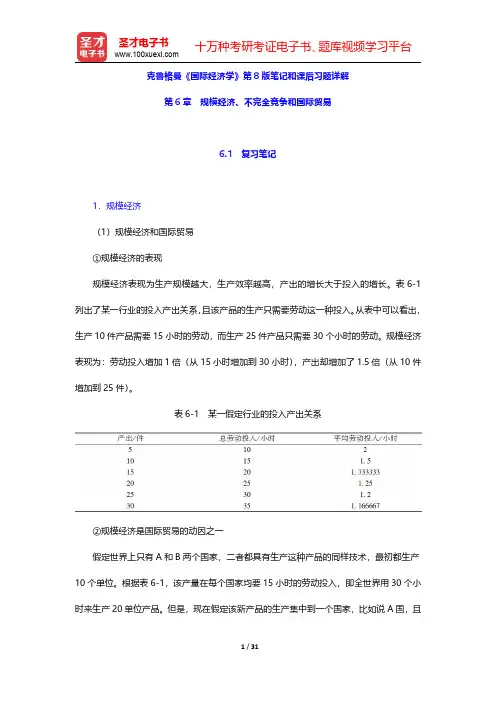
克鲁格曼《国际经济学》第8版笔记和课后习题详解第6章规模经济、不完全竞争和国际贸易6.1复习笔记1.规模经济(1)规模经济和国际贸易①规模经济的表现规模经济表现为生产规模越大,生产效率越高,产出的增长大于投入的增长。
表6-1列出了某一行业的投入产出关系,且该产品的生产只需要劳动这一种投入。
从表中可以看出,生产10件产品需要15小时的劳动,而生产25件产品只需要30个小时的劳动。
规模经济表现为:劳动投入增加1倍(从15小时增加到30小时),产出却增加了1.5倍(从10件增加到25件)。
表6-1某一假定行业的投入产出关系②规模经济是国际贸易的动因之一假定世界上只有A和B两个国家,二者都具有生产这种产品的同样技术,最初都生产10个单位。
根据表6-1,该产量在每个国家均要15小时的劳动投入,即全世界用30个小时来生产20单位产品。
但是,现在假定该新产品的生产集中到一个国家,比如说A国,且A国在这一行业也投入30个小时的劳动。
然而,在一个国家内投入30个小时的劳动,却能生产出25件产品。
显然,生产集中到A国可以使得世界以同样的劳动投入多产出25%的产品。
可见,各国可以用比以往更有效的规模专业化地生产有限类别的产品;同时,它们之间的相互贸易又使得消费所有产品成为可能。
(2)规模经济和市场结构①规模经济的分类a.外部规模经济,指单位产品成本取决于整个行业规模而非单个厂商规模的规模经济类型。
b.内部规模经济,指单位产品成本取决于单个厂商的规模而不是其所在的行业规模的规模经济类型。
②规模经济对市场结构的影响外部的和内部的规模经济对市场结构具有不同的影响。
一个只存在外部规模经济的行业(即大厂商没有优势)一般由许多相对较小的厂商构成,且处于完全竞争的状态;相反,存在内部规模经济的行业中,大厂商比小厂商更具有成本优势,就形成了不完全竞争的市场结构。
外部规模经济和内部规模经济都是国际贸易的重要原因。
但是,由于它们对市场结构的影响不同,下面将对它们进行分别讨论。
克鲁格曼《国际经济学》笔记和课后习题详解(发展中国家的贸易政策)【圣才出品】
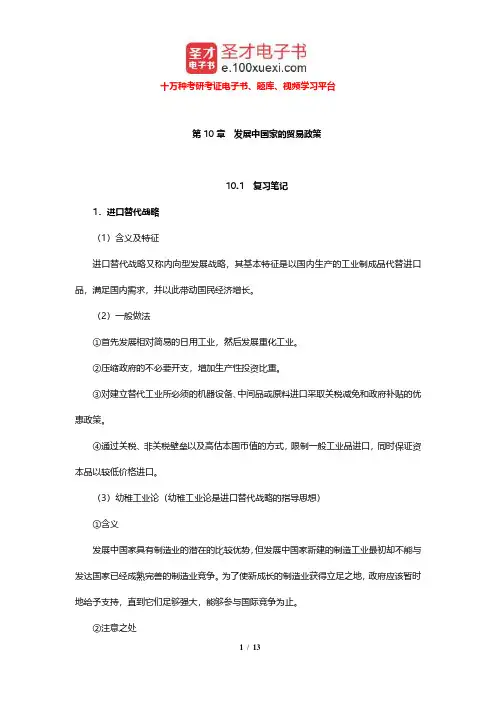
十万种考研考证电子书、题库、视频学习平台第10章发展中国家的贸易政策10.1 复习笔记1.进口替代战略(1)含义及特征进口替代战略又称内向型发展战略,其基本特征是以国内生产的工业制成品代替进口品,满足国内需求,并以此带动国民经济增长。
(2)一般做法①首先发展相对简易的日用工业,然后发展重化工业。
②压缩政府的不必要开支,增加生产性投资比重。
③对建立替代工业所必须的机器设备、中间品或原料进口采取关税减免和政府补贴的优惠政策。
④通过关税、非关税壁垒以及高估本国币值的方式,限制一般工业品进口,同时保证资本品以较低价格进口。
(3)幼稚工业论(幼稚工业论是进口替代战略的指导思想)①含义发展中国家具有制造业的潜在的比较优势,但发展中国家新建的制造工业最初却不能与发达国家已经成熟完善的制造业竞争。
为了使新成长的制造业获得立足之地,政府应该暂时地给予支持,直到它们足够强大,能够参与国际竞争为止。
②注意之处十万种考研考证电子书、题库、视频学习平台a.试图从现在就进入未来才会具有比较优势的产业,并不总能得到好处。
b.如果政府保护本身有助于培养制造业的竞争力,那么保护才是值得的。
反之,则不值得。
总之,只有存在某种国内市场失灵的情况下,幼稚工业论才能成为政府干预的有效论据。
③市场失灵幼稚工业是否需要保护取决于幼稚工业的保护必须与一种具体的市场失灵相联系,这种市场失灵会使得私有市场不能以应有的速度发展这一产业。
有两种类型的市场失灵可以作为保护幼稚工业的依据:不完全资本市场和无偿占用问题。
a.不完全资本市场作为保护幼稚工业的依据认为,如果一个发展中国家没有一整套金融机构可以使得传统部门的储蓄用于新成长部门的投资,那么新工业部门的增长将会受这些工业当前盈利能力的限制。
最优政策是建立更完善的资本市场。
但是,由于对这些幼稚工业的保护可以提高利润,从而使其更快成长,所以保护幼稚工业可以作为次优的政策选择。
b.无偿占用问题的思想是:新产业产生的社会福利没有得到补偿。
国际经济学(克鲁格曼)课后习题答案1-8章
第一章练习与答案1.为什么说在决定生产和消费时,相对价格比绝对价格更重要?答案提示:当生产处于生产边界线上,资源则得到了充分利用,这时,要想增加某一产品的生产,必须降低另一产品的生产,也就是说,增加某一产品的生产是有机会机本(或社会成本)的。
生产可能性边界上任何一点都表示生产效率和充分就业得以实现,但究竟选择哪一点,则还要看两个商品的相对价格,即它们在市场上的交换比率。
相对价格等于机会成本时,生产点在生产可能性边界上的位置也就确定了。
所以,在决定生产和消费时,相对价格比绝对价格更重要。
2.仿效图1—6和图1—7,试推导出Y商品的国民供给曲线和国民需求曲线。
答案提示:3.在只有两种商品的情况下,当一个商品达到均衡时,另外一个商品是否也同时达到均衡?试解释原因。
答案提示:4.如果生产可能性边界是一条直线,试确定过剩供给(或需求)曲线。
答案提示:5.如果改用Y商品的过剩供给曲线(B国)和过剩需求曲线(A 国)来确定国际均衡价格,那么所得出的结果与图1—13中的结果是否一致?答案提示:国际均衡价格将依旧处于贸易前两国相对价格的中间某点。
6.说明贸易条件变化如何影响国际贸易利益在两国间的分配。
答案提示:一国出口产品价格的相对上升意味着此国可以用较少的出口换得较多的进口产品,有利于此国贸易利益的获得,不过,出口价格上升将不利于出口数量的增加,有损于出口国的贸易利益;与此类似,出口商品价格的下降有利于出口商品数量的增加,但是这意味着此国用较多的出口换得较少的进口产品。
对于进口国来讲,贸易条件变化对国际贸易利益的影响是相反的。
7.如果国际贸易发生在一个大国和一个小国之间,那么贸易后,国际相对价格更接近于哪一个国家在封闭下的相对价格水平?答案提示:贸易后,国际相对价格将更接近于大国在封闭下的相对价格水平。
8.根据上一题的答案,你认为哪个国家在国际贸易中福利改善程度更为明显些?答案提示:小国。
9*.为什么说两个部门要素使用比例的不同会导致生产可能性边界曲线向外凸?答案提示:第二章答案1.根据下面两个表中的数据,确定(1)贸易前的相对价格;(2)比较优势型态。
克鲁格曼《国际经济学》笔记和课后习题详解(国民收入核算与国际收支平衡)【圣才出品】
克鲁格曼《国际经济学》笔记和课后习题详解(国民收⼊核算与国际收⽀平衡)【圣才出品】⼗万种考研考证电⼦书、题库、视频学习平台第12章国民收⼊核算与国际收⽀平衡12.1 复习笔记1.国民收⼊账户(1)GNP宏观经济分析的主要着眼点是⼀国的国民⽣产总值(GNP),它是⼀国的⽣产要素在⼀定时期内所⽣产并在市场上卖出的最终商品和服务的价值总量。
GNP是宏观经济学家研究⼀国产出时所⽤的基本度量⼿段,由花费在最终产品上的⽀出的市场价值量加总⽽得到。
GNP的⽀出与劳动、资本以及其他⽣产要素紧密相连。
根据购买最终产品的四种可能⽤途,GNP可以分解为以下四个部分:消费(国内居民私⼈消费的数额)、投资(私⼈企业为进⾏再⽣产⽽留下的⽤于购买⼚房设备的数额)、政府购买(政府使⽤的数额)和经常项⽬余额(对外净出⼝的商品和服务的数额)。
(2)国民收⼊国民收⼊等于GNP减去折旧,加上净单边转移⽀付,再减去间接商业税。
即:国民收⼊=GNP-折旧+净单边转移⽀付-间接商业税在实际经济中,要使GNP和国民收⼊的恒等关系完全成⽴,必须对GNP的定义作⼀定调整:①GNP不考虑机器和建筑物在使⽤过程中由于磨损⽽引起的经济损失。
这部分经济损失称为折旧,折旧减少了资本所有者的收⼊。
为了计算⼀定时期的国民收⼊,必须从GNP 中减去这⼀时期资本的折旧。
GNP减去折旧后称为国民⽣产净值(NNP)。
⼗万种考研考证电⼦书、题库、视频学习平台②⼀国的收⼊可能会包括外国居民的赠与,这种赠与称为单边转移⽀付。
单边转移⽀付的例⼦包括向居住在国外的退休公民⽀付养⽼⾦、赔偿⽀付和对遭受旱灾国家的救济援助等。
净单边转移⽀付是⼀国收⼊的⼀部分,但不是⼀国产出的⼀部分,因此,净单边转移⽀付,必须加到NNP中以计算国民收⼊。
③国民收⼊取决于⽣产者获得的产品价格,GNP则取决于购买者所⽀付的价格。
但是,这两组价格并不是完全⼀致的,例如,销售税会使得购买者的⽀付⼤于销售者的收⼊,导致GNP被⾼估,超过了国民收⼊。
克鲁格曼《国际经济学》(第8版)课后习题详解(第4章 资源、比较优势与收入分配)【圣才出品】
第4章资源、比较优势与收入分配一、概念题1.充裕要素(abundant factor)答:充裕要素是“稀缺要素”的对称,是指一国相对充裕的生产要素。
充裕要素的“充裕”是相对的,指的并不是一国所拥有的该生产要素的绝对数量的充裕,而是该生产要素相对于其他生产要素的相对充裕。
充裕要素是以资源禀赋解释国际贸易的赫克歇尔-俄林定理中的重要概念。
根据赫克歇尔-俄林定理,各国倾向于生产并出口国内充裕要素密集型的产品,一国充裕要素的所有者能够从国际贸易中获利。
2.要素价格(factor prices)答:要素价格即生产要素的价格,是指每一单位的生产要素在一定时期内给所有者带来的收入。
生产要素主要有四种:劳动力、土地、资本和企业家才能。
相应地,其价格分别称为工资、地租、利息和利润。
生产要素价格同产品的价格一样,主要是由生产要素市场上供求的相互作用决定的。
在市场经济中,工资主要由劳动力市场上的供求关系决定;地租主要由土地市场上的供求关系决定;利息主要由资本市场上的供求关系决定;利润作为企业家收入,主要由企业家市场上的供求关系决定。
3.生产可能性边界的偏向性扩张(biased expansion of production possibilities)答:生产可能性边界的偏向性扩张是指生产可能性边界在一个方向上扩张的幅度大于在另一方向上扩张的幅度,如图4-1所示。
图4-1(a)说明了生产可能性曲线偏向于X的扩张,图4-1(b)则说明了生产可能性曲线偏向Y的扩张。
图中的生产可能性边界都从1TT移到了2TT。
图4-1 生产可能性边界的偏向性扩张4.要素比例理论(factor-proportions theory)答:要素比例理论又称“赫克歇尔-俄林理论”、“生产要素禀赋理论”,是指从资源禀赋角度对国际贸易中生产成本和价格的差异做出解释的国际贸易理论。
要素比例理论的主要内容是:国际贸易源于不同国家之间商品的价格存在差异,而价格差异的原因在于不同国家生产成本有高有低,生产成本的高低又是因为各国生产要素价格有差别,生产要素价格的差别又与各国生产要素丰裕程度密切相关。
克鲁格曼《国际经济学》第八版课后答案
Chapter 18The International Monetary System, 1870–1973?Chapter OrganizationMacroeconomic Policy Goals in an Open EconomyInternal Balance: Full Employment and Price-Level StabilityExternal Balance: The Optimal Level of the Current Account International Macroeconomic Policy under the Gold Standard, 1870–1914 Origins of the Gold StandardExternal Balance under the Gold StandardThe Price-Specie-Flow MechanismThe Gold Standard “Rules of the Game”: Myth and RealityBox: Hume v. the MercantilistsInternal Balance under the Gold StandardCase Study: The Political Economy of Exchange Rate Regimes:Conflict over America’s Monetary Standard During the 1890s The Interwar Years, 1918–1939The Fleeting Return to GoldInternational Economic DisintegrationCase Study: The International Gold Standard and the Great Depression The Bretton Woods System and the International Monetary Fund Goals and Structure of the IMFConvertibility and the Expansion of Private Capital FlowsSpeculative Capital Flows and CrisesAnalyzing Policy Options under the Bretton Woods SystemMaintaining Internal BalanceMaintaining External BalanceExpenditure-Changing and Expenditure-Switching PoliciesThe External-Balance Problem of the United StatesCase Study: The Decline and Fall of the Bretton Woods SystemWorldwide Inflation and the Transition to Floating Rates Summary?Chapter OverviewThis is the first of five international monetary policy chapters. These chapters complement the preceding theory chapters in several ways. They provide the historical and institutional background students require to place their theoretical knowledge in a useful context. The chapters also allow students, through study of historical and current events, to sharpen their grasp of the theoretical models and to develop the intuition those models can provide. (Application of the theory to events of current interest will hopefully motivate students to return to earlier chapters and master points that may have been missed on the first pass.)Chapter 18 chronicles the evolution of the international monetary system from the gold standard of1870–1914, through the interwar years, and up to and including the post-World War II Bretton Woods regime that ended in March 1973. The central focus of the chapter is the manner in which each system addressed, or failed to address, the requirements of internal and external balance for its participants.A country is in internal balance when its resources are fully employed and there is price level stability. External balance implies an optimal time path of the current account subject to its being balanced over the long run. Other factors have been important in the definition of external balance at various times, and these are discussed in the text. The basic definition of external balance as an appropriate current-account level, however, seems to capture a goal that most policy-makers share regardless of the particular circumstances.The price-specie-flow mechanism described by David Hume shows how the gold standard could ensure convergence to external balance. You may want to present the following model of the price-specie-flow mechanism. This model is based upon three equations: 1. The balance sheet of the central bank. At the most simple level, this is justgold holdings equals the money supply: G ? M.2. The quantity theory. With velocity and output assumed constant and bothnormalized to 1, this yields the simple equation M ? P.3. A balance of payments equation where the current account is a function of thereal exchange rate and there are no private capital flows: CA ? f(E ? P*/P)These equations can be combined in a figure like the one below. The 45? line represents the quantity theory, and the vertical line is the price level where the real exchange rate results in a balanced current account. The economy moves along the 45? line back towards the equilibrium Point 0 whenever it is out of equilibrium. For example, the loss of four-fifths of a country’s gold would put that country at Point a with lower prices and a lower money supply. The resulting real exchange rate depreciation causes a current account surplus which restores money balances as the country proceeds up the 45? line froma to 0.FigureThe automatic adjustment process described by the price-specie-flow mechanism is expedited by following “rules of the game” under which governments contract the domestic source components oftheir monetary bases when gold reserves are falling (corresponding to a current-account deficit) and expand when gold reserves are rising (the surplus case).In practice, there was little incentive for countries with expanding gold reserves to follow the “rules of the game.” This increased the contractionary burden shouldered by countries with persistent current account deficits. The gold standard also subjugated internal balance to the demands of external balance. Research suggests price-level stability and high employment were attained less consistently under the gold standard than in the post-1945 period.The interwar years were marked by severe economic instability. The monetization of war debt and of reparation payments led to episodes of hyperinflation in Europe. Anill-fated attempt to return to thepre-war gold parity for the pound led to stagnation in Britain. Competitive devaluations and protectionism were pursued in a futile effort to stimulate domestic economic growth during the Great Depression.These beggar-thy-neighbor policies provoked foreign retaliation and led to the disintegration of the world economy. As one of the case studies shows, strict adherence to the Gold Standard appears to have hurt many countries during the Great Depression.Determined to avoid repeating the mistakes of the interwar years, Allied economic policy-makers metat Bretton Woods in 1944 to forge a new international monetary system for the postwar world. The exchange-rate regime that emerged from this conference had at its center the . dollar. All other currencies had fixed exchange rates against the dollar, which itself had a fixed value in terms of gold.An International Monetary Fund was set up to oversee the system and facilitate its functioning by lending to countries with temporary balance of payments problems.A formal discussion of internal and external balance introduces the concepts of expenditure-switching and expenditure-changing policies. The Bretton Woods system, with its emphasis on infrequent adjustmentof fixed parities, restricted the use of expenditure-switching policies. Increases in U.S. monetary growth to finance fiscal expenditures after the mid-1960s led to a loss of confidence in the dollar and the termination of the dollar’s convertibility into gold. The analysis presented in the text demonstrateshow the Bretton Woods system forced countries to “import” inflation from the United States and shows that the breakdown of the system occurred when countries were no longer willing to accept this burden.?Answers to Textbook Problems1. a. Since it takes considerable investment to develop uranium mines, you wouldwant a larger current account deficit to allow your country to finance some of the investment with foreign savings.b. A permanent increase in the world price of copper would cause a short-termcurrent account deficit if the price rise leads you to invest more in coppermining. If there are no investment effects, you would not change yourexternal balance target because it would be optimal simply to spend youradditional income.c. A temporary increase in the world price of copper would cause a currentaccount surplus. You would want to smooth out your country’s consumption bysaving some of its temporarily higher income.d. A temporary rise in the world price of oil would cause a current accountdeficit if you were an importer of oil, but a surplus if you were an exporter of oil.2. Because the marginal propensity to consume out of income is less than 1, atransfer of income from B to A increases savings in A and decreases savings in B.Therefore, A has a current account surplus and B has a corresponding deficit.This corresponds to a balance of payments disequilibrium in Hume’s world, which must be financed by gold flows from B to A. These gold flows increase A’s money supply and decrease B’s money supply, pushing up prices in A and depressingprices in B. These price changes cease once balance of payments equilibrium has been restored.3. Changes in parities reflected both initial misalignments and balance of paymentscrises. Attempts to return to the parities of the prewar period after the war ignored the changes in underlying economic fundamentals that the war caused. This made some exchange rates less than fully credible and encouraged balance ofpayments crises. Central bank commitments to the gold parities were also less than credible after the wartime suspension of the gold standard, and as a result of the increasing concern of governments with internal economic conditions.4. A monetary contraction, under the gold standard, will lead to an increase in thegold holdings of the contracting country’s central bank if other countries do not pursue a similar policy. All countries cannot succeed in doing thissimultaneously since the total stock of gold reserves is fixed in the short run.Under a reserve currency system, however, a monetary contraction causes anincipient rise in the domestic interest rate, which attracts foreign capital. The central bank must accommodate the inflow of foreign capital to preserve theexchange rate parity. There is thus an increase in the central bank’s holdings of foreign reserves equal to the fall in its holdings of domestic assets. There is no obstacle to a simultaneous increase in reserves by all central banksbecause central banks acquire more claims on the reserve currency country while their citizens end up with correspondingly greater liabilities.5. The increase in domestic prices makes home exports less attractive and causes acurrent account deficit. This diminishes the money supply and causescontractionary pressures in the economywhich serve to mitigate and ultimately reverse wage demands and price increases.6. A “demand determined” increase in dollar reserve holdings would not affect theworld supply of money as central banks merely attempt to trade their holdings of domestic assets for dollar rese rves. A “supply determined” increase in reserve holdings, however, would result from expansionary monetary policy in the United States (the reserve center). At least at the end of the Bretton Woods era the increase in world dollar reserves arose in part because of an expansionarymonetary policyin the United States rather than a desire by other central banks to increasetheir holdings of dollar assets. Only the “supply determined” increase indollar reserves is relevant for analyzing the relationship between world holdings of dollar reserves by central banks and inflation.7. An increase in the world interest rate leads to a fall in a central bank’sholdings of foreign reserves as domestic residents trade in their cash forforeign bonds. This leads to a d ecline in the home country’s money supply. The central bank of a “small” country cannot offset these effects sinceit cannot alter the world interest rate. An attempt to sterilize the reserve loss through open market purchases would fail unless bonds are imperfect substitutes.8. Capital account restrictions insulate the domestic interest rate from the worldinterest rate. Monetary policy, as well as fiscal policy, can be used to achieve internal balance. Because there are no offsetting capital flows, monetary policy, as well as fiscal policy, can be used to achieve internal balance. The costs of capital controls include the inefficiency which is introduced when the domestic interest rate differs from the world rate and the high costs of enforcing the controls.9. Yes, it does seem that the external balance problem of a deficit country is moresevere. While the macroeconomic imbalance may be equally problematic in the long run regardless of whether it is a deficit or surplus, large external deficits involve the risk that the market will fix the problem quickly by ceasing to fund the external deficit. In this case, there may have to be rapid adjustment that could be disruptive. Surplus countries are rarely forced into rapid adjustments, making the problems less risky.10. An inflow attack is different from capital flight, but many parallels exist. Inan “outflow” attack, speculators sell the home currency and drain the central bank of its foreign assets. The central bank could always defend if it so chooses (they can raise interest rates to improbably high levels), but if it is unwilling to cripple the economy with tight monetary policy, it must relent. An “inflow”attack is similar in that the central bank can always maintain the peg, it is just that the consequences of doing so may be more unpalatable than breaking the peg. If money flows in, the central bank must buy foreign assets to keep thecurrency from appreciating. If the central bank cannot sterilize all the inflows (eventually they may run out of domestic assets to sell to sterilize thetransactions where they are buying foreign assets), it will have to either let the currency appreciate or let the money supply rise. If it is unwilling to allow and increase in inflation due to a rising money supply, breaking the peg may be preferable.11. a. We know that China has a very large current account surplus, placing them highabove the XX line. They also have moderate inflationary pressures (describedas “gathering” in the question, implying they are not yet very strong). This suggests that China is above the II line, but not too far above it. It wouldbe placed in Zone 1 (see below).b. China needs to appreciate the exchange rate to move down on the graph towardsbalance. (Shown on the graph with the dashed line down)c. China would need to expand government spending to move to the right and hitthe overall balance point. Such a policy would help cushion the negativeaggregate demand pressurethat the appreciation might generate.。
- 1、下载文档前请自行甄别文档内容的完整性,平台不提供额外的编辑、内容补充、找答案等附加服务。
- 2、"仅部分预览"的文档,不可在线预览部分如存在完整性等问题,可反馈申请退款(可完整预览的文档不适用该条件!)。
- 3、如文档侵犯您的权益,请联系客服反馈,我们会尽快为您处理(人工客服工作时间:9:00-18:30)。
第1篇国际贸易理论第2章世界贸易概览2.1复习笔记1.经济规模与进出口总额之间的关系(1)规模问题:引力模型现实证明一国的经济规模与其进出口总额息息相关。
把整个世界贸易看成整体,可利用引力模型(gravity model)来预测任意两国之间的贸易规模。
引力模型方程式如下:其中,T是i国与j国的贸易额,A为常量,i Y是i国的国内生产总值,j Y是j国的国ij内生产总值,D是两国的距离。
引力模型方程式表明:其他条件不变的情况下,两国间的ij贸易规模与两国的GDP成正比,与两国间的距离成反比。
(2)引力模型的内在逻辑引力模型之所以能较好地拟合两国之间的实际贸易现状,其原因在于:大的经济体收入高,因而大量进口产品;大的经济体能生产更多品种的系列产品,因而更能满足其他国家的需求,进而大量出口产品。
在两国贸易中,任一方的经济规模越大,则双方的贸易量就越大。
(3)引力模型的应用:寻找反例当两国之间的贸易量与依照引力模型计算得出的结果相差较大时,就需要从其他因素进行分析,如文化的亲和性、地理位置、运输成本等因素。
事实上,这也是引力模型的重要用途之一,即有助于明确国际贸易中的异常现象。
(4)贸易障碍:距离、壁垒和疆界距离、壁垒和疆界对国际贸易有负面作用,会使得两国之间的贸易额大大小于根据引力模型所计算出的结果。
另外,在各国GDP和距离给定的情况下,有效贸易协定(trade agreement)比无效的贸易协定更能显著增加成员国的贸易量,这也是美国与其邻国的贸易量明显大于其和相同大小的欧盟的贸易量的原因之一。
2.正在演变的世界贸易模式(1)世界变小了吗?人们认为,现代化的运输和通讯可以超越空间距离的束缚,世界因此成了小“村落”。
事实的确如此。
但是,有时候政治的力量可以超过技术进步的作用,两次世界大战、20世纪30年代的大萧条及战后全世界范围内的贸易保护主义等都严重制约着国际贸易的发展,使得国际贸易大幅萎缩,并且用了几十年才得以恢复。
(2)交易内容从全世界范围来看,工业制成品是主要的交换产品,所占比重最大。
矿产品特别是现代世界不可或缺的石油依旧是世界贸易的主要部分。
引人注目的是发展中国家已经从初级产品出口国转变为主要的制成品出口国。
另外,服务贸易在国际贸易中凸显重要,并且其重要性越来越突出。
(3)服务外包随着现代信息技术的发展和应用,一种新的贸易形式——服务外包(service outsourcing)随之出现。
服务外包也称之为离岸服务,是一种新兴的国际贸易现象,使得曾经必须在一国国内实现的服务现在可以在国外实现。
(4)旧规则依然可行吗?即便国际贸易发生了巨大变化,但是由经济学家在经济全球化之初所发现的基本原理依然可行,国际贸易潜在的逻辑并没有改变。
2.2课后习题详解一、概念题1.发展中国家(developing countries)答:发展中国家是与发达国家相对的经济上比较落后的国家,又称“欠发达国家”或“落后国家”。
通常指第三世界国家,包括亚洲、非洲、拉丁美洲及其他地区的130多个国家。
衡量一国是否为发展中国家的具体标准有很多种,如经济学家刘易斯和世界银行均提出过界定发展中国家的标准。
一般而言,凡人均收入低于美国人均收入的五分之一的国家就被定义为发展中国家。
比较贫困和落后是发展中国家的共同特点。
2.服务外包(service outsourcing)答:服务外包是指企业将其非核心的业务外包出去,利用外部最优秀的专业化团队来承接其业务,从而使其专注于核心业务,达到降低成本、提高效率、增强企业核心竞争力和对环境应变能力的一种管理模式。
20世纪90年代以来,随着信息技术的迅速发展,特别是互联网的普遍存在及广泛应用,服务外包得到蓬勃发展。
从美国到英国,从欧洲到亚洲,无论是中小企业还是跨国公司,都把自己有限的资源集中于公司的核心能力上而将其余业务交给外部专业公司,服务外包成为“发达经济中不断成长的现象”。
3.引力模型(gravity model)答:丁伯根和波伊赫能的引力模型基本表达式为:其中,T是i国与j国的贸易额,A为常量,i Y是i国的国内生产总值,j Y是j国的国ij内生产总值,D是两国的距离。
a、b、c三个参数是用来拟合实际的经济数据。
引力模型ij方程式表明:其他条件不变的情况下,两国间的贸易规模与两国的GDP成正比,与两国间的距离成反比。
把整个世界贸易看成整体,可利用引力模型来预测任意两国之间的贸易规模。
另外,引力模型也可以用来明确国际贸易中的异常现象。
4.第三世界(third world)答:第三世界这个名词原本是指法国大革命中的Third Estate(第三阶级)。
冷战时期,一些经济发展比较落后的国家为表示并不靠拢北约或华约任何一方,用“第三世界”一词界定自己。
1973年9月,不结盟国家在阿尔及尔通过的《政治宣言》中正式使用了“第三世界”这个概念。
第三世界包括亚洲、非洲、拉丁美洲及其他地区的130多个国家,占世界陆地面积和总人口的70%以上。
第三世界国家绝大多数过去都是帝国主义的殖民地或附属国,它们取得政治独立后,还面临着肃清殖民主义残余势力、发展民族经济、巩固民族独立的历史任务。
它们是维护世界和平的重要力量。
相对来说,第三世界国家都是不怎么发达且较贫困的国家。
5.国内生产总值(gross domestic product)答:国内生产总值是指在一定时期内(通常为一年),一个国家或地区的经济中所生产出的全部最终产品和服务的价值,常被公认为衡量国家经济状况的最佳指标。
它不但可反映一个国家的经济表现,更可以反映一国的国力与财富。
一般来说,国内生产总值共有四个不同的组成部分,即消费、私人投资、政府支出和净出口额。
6.贸易协定(trade agreement)答:贸易协定是指两个或两个以上的国家之间调整它们相互贸易关系的一种书面协议。
其特点是对缔约国之间的贸易关系规定得比较具体,有效期一般较短,签订的程序也比较简单,一般只须经过签字国的行政首脑或其代表签署即可生效。
贸易协定的内容通常包括:贸易额、双方出口货单、作价办法、使用的货币、支付方式、关税优惠等。
二、复习题1.加拿大和澳大利亚都是英语国家,两国的人口规模也相当(加拿大多60%),但是相对各自GDP而言,加拿大的贸易额是澳大利亚的两倍,为什么会如此?Canada and Australia are(mainly)English-speaking countries with populations that are not too different in size(Canada’s is60percent larger).But Canadian trade is twice as large,relative to GDP,as Australia’s.Why should this be the case?答:GDP不是解释两国贸易量的惟一重要因素,距离也是至关重要的因素之一。
考虑到距离,澳大利亚的进出口运输成本相对更高,因此减少了贸易的吸引力。
因为加拿大与美国相邻,而澳大利亚不与任何一个大经济体相邻,这使得加拿大更加开放,而澳大利亚更加自给自足。
2.墨西哥和巴西各自的贸易伙伴不同。
墨西哥主要与美国贸易,巴西与美国和欧盟的贸易量大致相当。
墨西哥的贸易量相对其GDP 而言很大。
用引力模型解释这种现象。
Mexico and Brazil have very different trading patterns.Mexico trades mainly with the United States,Brazil trades about equally with the United States and with the European Union;Mexico does much more trade relative to its GDP .Explain these differences using the gravity model.答:墨西哥与美国毗邻,但是距离欧盟很远,因此它与美国的贸易量很大。
巴西离美国和欧盟都很远,因此巴西与美国和欧盟的贸易量大致相当。
墨西哥贸易量比巴西大,其原因一方面由于墨西哥离大经济体(美国)近,另一方面由于它是北美自由贸易协定的成员国之一。
巴西远离任何一个大经济体,与它签订自由贸易协定的国家经济规模都比较小。
3.方程jij i ij Y T A Y D =⨯⨯说明任何两国的贸易额与其国内GDP 成正比。
如果这两个国家的GDP 都增加一倍,这是否意味着贸易要增加四倍。
用(教材中)表2-2中的简单例子分析这个问题。
Equation jij i ij Y T A Y D =⨯⨯says that trade between any two countries isproportional to the product of their GDPs.Does this mean that if the GDP of every country in the world doubled,world trade would quadruple?Analyze this question using the simple example shown in Table 2-2.答:如果这每个国家的GDP 都增加一倍,并不意味着贸易会增加四倍,可以用教材表2-2中的例子说明。
结合教材表2-2中的例子可以看出,如果这四个国家的GDP 都增加一倍,贸易也增加。
